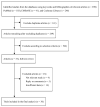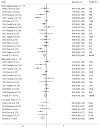Efficacy of Vitamin D Supplements in Prevention of Acute Respiratory Infection: A Meta-Analysis for Randomized Controlled Trials
- PMID: 35215468
- PMCID: PMC8879485
- DOI: 10.3390/nu14040818
Efficacy of Vitamin D Supplements in Prevention of Acute Respiratory Infection: A Meta-Analysis for Randomized Controlled Trials
Abstract
Background: Previous systematic reviews and meta-analyses of randomized controlled trials (RCTs) have reported inconsistent results regarding the efficacy of vitamin D supplements in the prevention of acute respiratory infections (ARIs).
Methods: We investigated these efficacy results by using a meta-analysis of RCTs. We searched PubMed, EMBASE, and the Cochrane Library in June 2021.
Results: Out of 390 trials searched from the database, a total of 30 RCTs involving 30,263 participants were included in the final analysis. In the meta-analysis of all the trials, vitamin D supplementation showed no significant effect in the prevention of ARIs (relative risk (RR) 0.96, 95% confidence interval (CI) 0.91-1.01, I2 = 59.0%, n = 30). In the subgroup meta-analysis, vitamin D supplementation was effective in daily supplementation (RR 0.83, 95% CI, 0.73-0.95, I2 = 69.1%, n = 15) and short-term supplementation (RR 0.83, 95% CI, 0.71-0.97, I2 = 66.8%, n = 13). However, such beneficial effects disappeared in the subgroup meta-analysis of high-quality studies (RR 0.89, 95% CI, 0.78-1.02, I2 = 67.0%, n = 10 assessed by the Jadad scale; RR 0.87, 95% CI, 0.66-1.15, I2 = 51.0%, n = 4 assessed by the Cochrane's risk of bias tool). Additionally, publication bias was observed.
Conclusions: The current meta-analysis found that vitamin D supplementation has no clinical effect in the prevention of ARIs.
Keywords: acute respiratory infections; meta-analysis; randomized controlled trial; vitamin D supplements.
Conflict of interest statement
All authors declare no conflict of interest.
Figures





Similar articles
-
Vitamin D supplementation for prevention of acute respiratory infections in older adults: A systematic review and meta-analysis.PLoS One. 2024 May 24;19(5):e0303495. doi: 10.1371/journal.pone.0303495. eCollection 2024. PLoS One. 2024. PMID: 38787821 Free PMC article.
-
Efficacy of Vitamin D Supplements in Treatment of Acute Respiratory Infection: A Meta-Analysis for Randomized Controlled Trials.Nutrients. 2022 Mar 8;14(6):1144. doi: 10.3390/nu14061144. Nutrients. 2022. PMID: 35334804 Free PMC article.
-
Optimal methods of vitamin D supplementation to prevent acute respiratory infections: a systematic review, dose-response and pairwise meta-analysis of randomized controlled trials.Nutr J. 2024 Aug 14;23(1):92. doi: 10.1186/s12937-024-00990-w. Nutr J. 2024. PMID: 39143549 Free PMC article.
-
Vitamin D supplementation to prevent acute respiratory infections: a systematic review and meta-analysis of aggregate data from randomised controlled trials.Lancet Diabetes Endocrinol. 2021 May;9(5):276-292. doi: 10.1016/S2213-8587(21)00051-6. Epub 2021 Mar 30. Lancet Diabetes Endocrinol. 2021. PMID: 33798465
-
Effects of intermittent or single high-dose vitamin D supplementation on risk of falls and fractures: a systematic review and meta-analysis.Osteoporos Int. 2023 Aug;34(8):1355-1367. doi: 10.1007/s00198-023-06761-3. Epub 2023 Apr 29. Osteoporos Int. 2023. PMID: 37120684
Cited by
-
Select Dietary Supplement Ingredients for Preserving and Protecting the Immune System in Healthy Individuals: A Systematic Review.Nutrients. 2022 Nov 1;14(21):4604. doi: 10.3390/nu14214604. Nutrients. 2022. PMID: 36364865 Free PMC article.
-
Cost-utility of vitamin D supplementation to prevent acute respiratory infections in children.Cost Eff Resour Alloc. 2023 Apr 6;21(1):23. doi: 10.1186/s12962-023-00433-z. Cost Eff Resour Alloc. 2023. PMID: 37024913 Free PMC article.
-
No causal association between serum vitamin D levels and bronchiectasis: A Mendelian randomization analysis.Medicine (Baltimore). 2024 Dec 6;103(49):e40824. doi: 10.1097/MD.0000000000040824. Medicine (Baltimore). 2024. PMID: 39654221 Free PMC article.
-
Vitamin D, Menopausal Health and COVID-19: Critical Appraisal of Current Data.J Clin Med. 2023 Jan 24;12(3):916. doi: 10.3390/jcm12030916. J Clin Med. 2023. PMID: 36769563 Free PMC article. Review.
-
Vitamin D supplementation for prevention of acute respiratory infections in older adults: A systematic review and meta-analysis.PLoS One. 2024 May 24;19(5):e0303495. doi: 10.1371/journal.pone.0303495. eCollection 2024. PLoS One. 2024. PMID: 38787821 Free PMC article.
References
-
- Barrett B.T., Goldman R.B. Chapter 337: The common cold. In: Goldman L., Schafer A.I., editors. Cecil Medicine. 26th ed. Elsevier; Amsterdam, The Netherlands: 2019. pp. 2150–2152.
-
- Musher D.M. Chapter 91: Overview of pneumonia. In: Goldman L., Schafer A.I., editors. Cecil Medicine. 26th ed. Elsevier; Amsterdam, The Netherlands: 2019. pp. 592–603.
-
- Troeger C., Forouzanfar M., Rao P.C., Khalil I., Brown A., Swartz S., Fullman N., Mosser J., Thompson R.L., Reiner R.C., Jr., et al. Estimates of the global, regional, and national morbidity, mortality, and aetiologies of lower respiratory tract infections in 195 countries: A systematic analysis for the Global Burden of Disease Study 2015. Lancet Infect. Dis. 2017;17:1133–1161. doi: 10.1016/S1473-3099(17)30396-1. - DOI - PMC - PubMed
Publication types
MeSH terms
Substances
LinkOut - more resources
Full Text Sources
Medical

